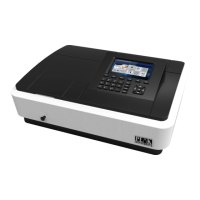6) Stray light: wavelength of stray light is irradiated onto the non-selection signal generated by the detector. It is an
important source of photometric analysis of errors, stray light limit the accuracy of the General Assembly high
concentration solution analysis. Stray light represented by T%;
7) Photometric range: Refers to meet the photometric test range in various technical indicators, represented by A or
T;
8) Photometric accuracy: the true average value refers to the degree of compliance with a plurality of measured;
photometric accuracy check is usually through the use of repeated measurements of the neutral density filter
carefully film to a standard photometric detection. A neutral density filter for light in a wavelength range having
almost the same transmittance (or absorbance) of the filter, and the use of its wavelength insensitive characteristic
bandwidth changes, to check the accuracy of the optical instrument and repeatability.
9) Photometric Repeatability: refers several times under the same conditions as measured in parallel, each parallel
line with the degree of determination between the results;
10) Noise: the sum of the instrument detects the unwanted signals, which is the purpose of the relative signal.
Generally, the spectrophotometer has two sources of noise, one from the light source, the second is derived from
the internal electronic noise inherent in the instrument, such as: power supply, amplifier, AD conversion and the like.
To reduce noise, improve signal to noise ratio, there must be a good electrical design. Noise measurement
repeatability test under low concentrations, but also affect test accuracy. Noise by averaging several measurements
after partial elimination;
11) Drift: refers to the degree of deviation from the instrument over time the starting value. It depends on the
stability, light stability of the electrical device and the like. Single-beam instrument, the warm-up time has a great
influence on the length of the drift.
12) Baseline flatness: refers to the distribution of the full wavelength range of the instrument noise.
3. Application
Subjects available for physics, chemistry, medicine, biology, pharmacology, geology and other scientific research, is
widely used in chemical, pharmaceutical, biological and chemical, metallurgy, light industry, materials,
environmental protection, medicine and other industries and laboratory analysis of the industry's most one
important quality control instruments, is essential for routine laboratory instruments.
4. Using conditions
Equipment should be installed away from the hot or humid environment. The instrument should be used in 16-35 ℃,
45-80% humidity conditions. Please try to stay away from issuing magnetic, electric, high-frequency waves of
electrical devices, do not install the instrument in the air chlorine, hydrochloric acid gas, hydrogen sulfide gas, such
as sulfurous acid gas, corrosive gas Excessive places. Place the instrument table should be smooth, without

